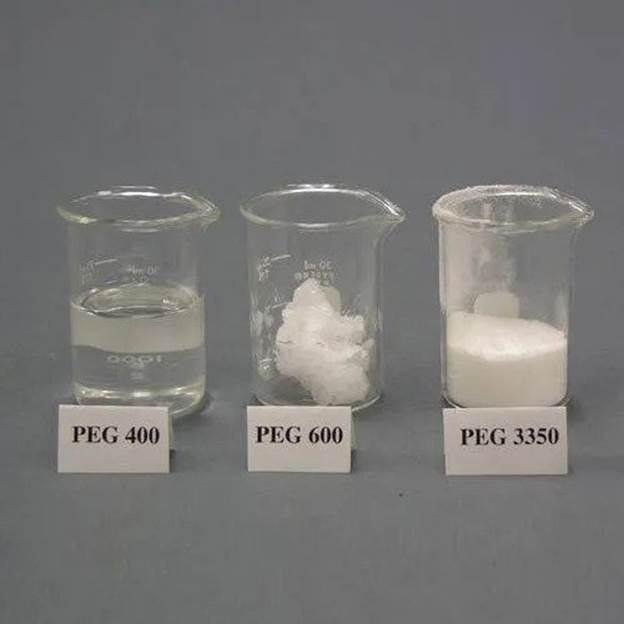The medical, chemical, and industrial fields greatly benefit from multiple uses of polyethylene glycol (PEG). PEG is a synthetic, hydrophobic polyether molecule that is biocompatible.
see our products:
Polyethylene glycol characteristics
Changing Polyethylene glycol’s molecular weight has only a marginal impact on its properties, mainly on its form and physical appearance. It has no health risks, has no discernible flavor or aroma, and does not give off any noticeable or appreciable heat or light. It dissolves very well in organic solvents, including benzene, carbon tetrachloride, and chloroform, as well as in water. Developing PEG with varying chain lengths allows for producing compounds with a wide range of molecular weights. When comparing PEG molecules of varying sizes, it can be shown that the larger ones have more structural repetitions.
Applications of Polyethylene glycol
Polyethylene glycol’s non-toxicity and excellent solubility make it useful in many areas of medicine. Several over-the-counter and prescription laxatives and whole-bowel irrigations, ointments, and solvents contain this ingredient. It has multiple potential applications as a surface coating on nanoparticles, as a carrier for a medication, or as a bioconjugate to a specific target. In addition to its usage as a precipitant for DNA isolation and cell crystallization, PEG is also used in the biomedical field of protein analysis. Vectors, such as viruses, used in gene therapy are coated with PEG to prevent their destruction by the immune system and to prevent them from being targeted by the body’s organs. PEG hydrogels have found additional applications in drug delivery, tissue engineering, and in vitro tests. PEG is used widely in the chemical industry as a binding and dispersion agent to stop proteins from attaching for no reason and because it is non-toxic and considered safe by the Food and Drug Administration.
What are Polyethylene glycol powder and Polyethylene glycol 400?
Regularly using Polyethylene glycol powder can help with occasional constipation. It helps because of the way it enhances the intestinal absorption of water. This makes bowel movements less difficult by softening the feces. In addition, the increased pressure causes the intestinal muscles to contract, causing feces to be expelled. It’s categorized with other laxative drugs. The drug has the potential for additional applications. Co-solvents like Polyethylene glycol 400 are often used. Dry, irritated eyes can be treated with this medicine. Wind, sun, heating/air conditioning, computer use/reading, and several medications are common causes of dry eyes.
Polyethylene glycol in food

Polyethylene glycol in food
The food sold in supermarkets might have a wide variety of components. Flavor enhancers and preservatives are two types of additives. Polyethylene glycol in food, typically found in salad dressing, is a frequently used component. It’s included in many personal care goods, pet food, and soaps.
Propylene Glycol-Containing Foods
Polyethylene glycol’s many valuable qualities make it an ideal choice for food packaging. The food industry widely uses it to extend the storage life of processed foods. This substance can be found in a variety of packaged foods, like as:
- Many seasoning combinations
- Dried soups
- Dressings for salads
- Cake, muffin, cinnamon bun, biscuit, cupcake, and pancake mixes
- Dry drink mixes
- Flavored teas
- Soft drinks
- Alcoholic beverages
- Food coloring
- And…
Polyethylene Glycol is used in the food industry for a wide variety of reasons, including as a preservative, taste enhancer, emulsifier, texturizer, and processing aid to improve the overall quality of the product. So, when buying food, be sure to check out Polyethylene brand Name.
Possible Risks to Your Health
Some who are opposed to using propylene glycol in food point out that current levels in foods are much higher than what is recommended by the World Health Organization. Regarding propylene glycol, the World Health Organization sets the safe limit at 25 milligrams per kilogram of body weight. Rarely does propylene glycol cause toxicity. Despite this, many advise cutting back on your intake because of the potential health problems that may arise:
- Signs of liver and kidney failure worsen
- Allergic reactions
- Increased rate of heart attacks
How to keep Polyethylene glycol out of your food
Polyethylene Glycol is found in nearly all processed foods. Despite its modest toxicity, a high intake of foods containing this chemical may cause health problems. To minimize exposure, you should avoid anything that may have the chemical. Eat more natural, fresh meals.

